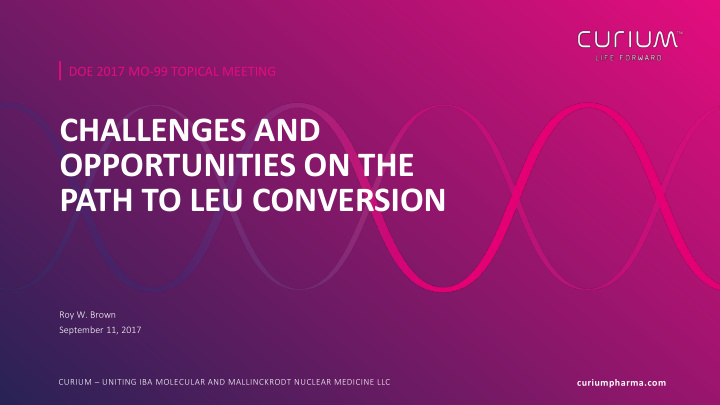



DOE 2017 MO-99 TOPICAL MEETING CHALLENGES AND OPPORTUNITIES ON THE PATH TO LEU CONVERSION Roy W. Brown September 11, 2017 CURIUM – UNITING IBA MOLECULAR AND MALLINCKRODT NUCLEAR MEDICINE LLC curiumpharma.com
INTRODUCTION INTRODUCING CURIUM
INTRODUCTION • January 27, 2017 – Mallinckrodt Pharmaceuticals completed the sale of its Global Nuclear Imaging business to IBA Molecular CURIUM – UNITING • 100 years of combined experience in the nuclear IBA MOLECULAR AND medicine industry MALLINCKRODT NUCLEAR • Singular focus – to develop, manufacture and supply SPECT, PET and therapeutic radiopharmaceuticals MEDICINE LLC • More than 1,600 dedicated employees work to provide nuclear medicine products for over 14 million patients worldwide each year through 6,000 customers in 70 countries • Largest vertically integrated radiopharmaceutical manufacturing network with one global Molybdenum-99 production facility, three large SPECT manufacturing facilities, and close to 40 SPECT and PET radiopharmacies 3
DOE 2017 MO-99 TOPICAL MEETING CHALLENGES FACED DURING LEU CONVERSION PROJECT
LEU TARGET COMPOSITION The new LEU target was designed so it would meet the needs for Mo-99 production, reactor • compatibility and fabrication. The Al alloy cladding chosen for metallurgy principles contained a metallic impurity which • created a new chemistry removal challenge in the process development. The target manufacturing process at CERCA introduced another metallic impurity into the LEU • targets, which created a new chemistry removal challenge. Similar issues were also faced by Mo-99 processors NTP and IRE in their conversion efforts, • leading to longer development time. 5
RESOLVED METALLIC IMPURITY ISSUE IN ALLOY We confirmed the metallic impurity in the LEU targets formed oxides and clogged the • uranium filter, slowing the filtration process. We did not want to change the AG3 alloy in the new LEU target because it would have • added at least 12-18 months to the conversion. We designed/tested/validated a new uranium filter which could handle the metallic • impurity load and still optimize waste disposal. 6
RESOLVED METALLIC IMPURITY ISSUE IN TARGET Metallic contamination from target manufacturing process caused problems in the • radiochemistry process. Although Y-12 (Oak Ridge National Lab – U.S.) can control the level of metallic impurity in the • bulk LEU, that same metal was being added as part of the target manufacturing process. Any of this metallic impurity contained in the target as a contaminate, is activated to a • radionuclide of concern during the target irradiation process. Any of this radionuclide of concern present in the finished Mo-99 presents a problem. • We added an additional sorbent column to remove this metallic contaminant, and to ensure the • absence of any of this metal in the finished product. 7
OTHER CHALLENGES OVERCOME Unexpected shutdowns of the HFR and MARIA and the Be • matrix replacement in the BR2 during time scheduled for validation runs caused delays in the irradiation schedules. Previously drug regulatory agencies had a final material • specification check for gross alphas, whereas new requirements specified development of methods for sampling and measuring Pu-239, Am-231 and U-235 individually. Updated approval by the French transport competent • authority (ASN/IRSN) was needed for the Type B container we use to transport irradiated LEU targets from the MARIANNE target transport container reactors to our Petten site. 8
DOE 2017 MO-99 TOPICAL MEETING PROGRESS ON CONVERSION TO LEU
STEADY PROGRESS ON CURIUM’S LEU CONVERSION • Process development was completed in 2015. • Cold and hot testing completed in 2016. • Drug regulatory submissions made in early 2017. • EU drug regulatory approvals for LEU Mo-99 have been received. Curium's Petten Mo-99 • FDA drug regulatory approval for LEU Mo-99 has been received. Production Operation • Health Canada drug regulatory approval for LEU Mo-99 has been received. • Asia drug regulatory submissions had to wait until we received EU approvals, but have been filed. • New Marianne container approval for LEU targets has been received. • Nuclear Validation runs are nearing completion. • Completion of LEU conversion project still anticipated by the end of Marianne Transport Container 2017. 10
SUMMARY Curium began its LEU conversion project in 2010. • During that time we have resolved several technical development challenges in the • radiochemistry and analytical testing. Regulatory approvals from drug agencies and transport authorities were needed for the new • LEU targets. We have established arrangements with a diverse network of reactors to irradiate targets for • our Mo-99 production process. Curium has taken steps to steadily increase reliability and capacity of Mo-99 production to • account for loss of older reactors and for the loss of efficiency due to LEU conversion. LEU conversion is on schedule to be completed by the end of 2017. • 11
Recommend
More recommend